
|
|
Suggested Essential Reading
14 Books for Metahistorical Studies and Overview
The works cited are chosen to reflect
the five master themes that comprise the Arch of Metahistory, proposed under Guidelines. All
beliefs encoded in narratives about human experience or about things
imagined by human beings (such as the activity of gods or the evolution
of stars) are constellated by these themes, and so every variant
of every belief can be traced back to them. Narratives that describe
events as simple as the fall of Humpty Dumpty or as complex as
the fall of the Twin Towers are structurally based on these master
themes.
Notably, no book on the list presents a straightforward treatment
of history such as one finds, say, in The Decline and Fall of
the Roman Empire by Edward Gibbon. Half of the books cited
delve into a range of historical developments: the rise of civilization
in the Fertile Crescent, the problem of heresy in the early centuries
of the Christian era, ancient Jewish religion and apocalyptic sects,
Atlantis and archeological enigmas, the Minoan culture of ancient
Crete, and occult and fascist movements in the 20th century.
Of
the remaining books, four are specific studies of mythology: Pagan
Christs, The Myth of the Goddess, Memories and Visions of
Paradise and The Hero with a Thousand Faces. Angels
and Aliens and Supernature deal with aspects of the
paranormal, while Beyond Theology focuses on philosophical
speculations, and Gaia is about atmospheric science.
Where,
then, is the history in all this material?
As noted in the Guidelines, metahistory
is an inquiry into all kinds of stories to detect the beliefs
they encode. The emphasis on beliefs broadens the scope of the
inquiry and obliges us to realize that all versions of human knowledge
involve story-telling, even though they are not all histories in
the strict sense of the term. The explanation of pollination in
a botany book involves the story of the birds and the bees. The
theory of the Big Bang, which explains the origin and evolution
of the universe, is a story. History in the strict sense is an
account of events in the past, but metahistory is not limited to
this perspective. It is concerned with all forms of the narration
of human experience, all stories we invent to guide society and
confer purpose on life.
Pagan Christs by J. M. Robertson.
A cross-cultural inventory of mythological scripts that display
all the elements found in the story of Jesus Christ, the universal
savior of Christianity, whose life and deeds are held to be historically
unique by adherents to the faith. This book demonstrates the astounding
uniformity of plot-structure in the scripts attached to religious
belief-systems centered on a messiah or savior, the example of
divine sacrifice.
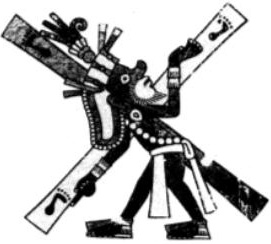
Many savior-type sun-gods preceded Jesus Christ: for example,
the Aztec God, "Yiacatechutli," shown here in an image from
a Pre-Columbian Codex drawn before Christian influence in the New
World. The figure is typical of solar deities who symbolically
sustain the four seasons, represented by the cross. This deity
is named "Lord of the Vanguard." The title is astronomically
correct, for the sun propels the solar system through space
by a screw-like
motion in which it occupies the apex and the four seasons recur
continually on the axis it generates.
(For a contrasting image,
see below, The Dead Sea Scrolls Deception.)
Beyond
Theology by Alan Watts. A lucid discussion of some primary
assumptions in Western religion, contrasted to other assumptions
found in Asian philosophy. Watts concentrates on the difference
between the belief that God is a father-figure who tests us and
the belief that Divinity is an awareness that plays with us,
operating through our own minds. Watts’ lucid and often
humorous treatment of the ways in which humanity explains its
relationship to the
Divine offers deep insights into the theme of Moral Design.
The Time Falling Bodies Take to Light by
William Irwin Thompson. A brilliant model of metahistorical overview,
this book delves into the origins of culture and civilization
as reflected in human sexuality. It is especially effective in
showing
how the patterns of experience in primordial time (Sacred Nature)
predetermine the rise of civilization (Origins), even though
the continuity with nature is ruptured as civilization develops.
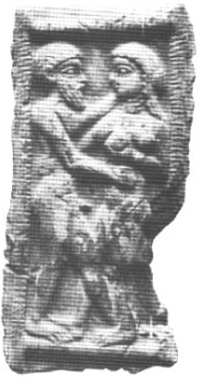
The notion that civilization is inspired by the love between a
Goddess and a human male is common to many ancient cultures. The
Erotic theme is lavishly developed in the Sumerian love poetry
that celebrates the theogamy (divine-human mating) of the Goddess
Inanna and the shepherd Dumuzi. According to Thompson, civilization
begins by making love, not war. (Lovers embracing, clay plaque,
Mesopotamia, 2000 BCE)
Memories and
Visions of Paradise by Richard Heinberg. A rich, well-arranged
inventory of mythic scripts that describe Paradise and the
Golden Age. This is a book full of inspiring stories about
an original
harmony from which humanity emerged into its present conflict
and confusion. It shows that whether or not the harmony ever
existed,
the nostalgia for it is real and powerful. Reflecting primarily
on the theme of Sacred Nature, this book also raises the question
of how humanity creates order once it has become separated
from the life-sustaining order of the natural world.
The Gnostic Gospels by
Elaine Pagels. A study of religious heresy, this book raises
many questions
concerning the master themes of Eternal Conflict (Good versus
Evil) and Moral Design. Drawing upon Gnostic teachings repressed
by the
Christian Church, it considers alternative scripts of sin and
redemption, contrasting with those received in Judaeo-Christian
tradition.
Side by side with the Dead Sea Scrolls, the Gnostic materials
cited here represent the greatest archeological textual find
of the 20th
Century.
The Hero with a Thousand Faces by
Joseph Campbell. A rich and dramatic recounting of the many
guises of the hero and the many variants of his quest. The
heros relation
to the Goddess (reflecting the master theme of Sacred Nature)
points to the origin . Moral Design is also implied, for the
hero is the primary
model of morality in pagan cultures and indigenous societies,
fully as important as the prophet, saint or messiah in societies
ruled
by the institutional religions.
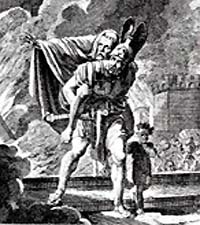
Stories of the origin of civilization often cite a founding
hero like the Trojan warrior Aeneas. His father, Anchises,
had mated
with the Goddess Aphrodite, another example of theogamy. After
fleeing Troy with Anchises on his shoulders, Aeneas went on
to become the mythical progenitor and "culture-hero" of the Roman
peoples. (Children’s book illustration.)
The
Myth of the Goddess by Anne Baring and Jules Cashford.
The best single overview of the lore of the Goddess found in
many cultures, this book focuses on the master theme of Sacred
Nature
which the Goddess universally embodies. It recovers and restores
many stories lost to humanity over the last two millennia due
to censorship by the patriarchal religions.
From Atlantis to the Sphinx by
Colin Wilson. A clear, informative resume of a wide range of
alternative scenarios of history, this book focuses on the long
controversy
over Atlantis, the exemplary lost civilization said to have existed
in pre-historic times (before 9000 BCE). It reflects equally
on the master themes of Origins and Technology because it explores
the controversial notion that high technology existed in prehistory.
Even if only a few of the speculations summarized in this book
are correct, the story of how civilization arose will have to
be
rewritten “from scratch.”
The Chalice and the Blade by
Riane Eisler. As the title indicates, this book explores the
master theme of Eternal Conflict expressed in the opposition
between aggression
(blade) and nurturing (chalice) throughout history. Taking Minoan
Crete for the model of an egalitarian but Goddess-oriented society
based on cooperation between the sexes, it skillfully develops
the argument against the male-defined "dominator society" called
patriarchy. It is especially valuable in presenting alternative
history as a basis for developing new options for sexual and
social relations in contemporary society.
Arktos by Jocelyn Godwin. A shocking
expose of the racial-religious theories that have inspired some
occult movements as well as the Nazi regime. This book describes
the origin of Aryan white supremacist scripts and the close links
between metaphysical (New Age) fantasy and fascist ideology.
In doing so it explores the master themes of Origins and Eternal
Conflict
within the framework of the catastrophic events of the 20th Century.
All three of the controversial A-words of metahistory — Atlantis,
Aquarius, Aryan — are treated in a sober and scholarly manner.
The Dead Sea Scrolls Deception by
Michael Baigent and Richard Leigh. Vivid journalistic and scholarly
account of the scandal surrounding the cover-up of the Dead Sea
Scrolls discovered in Israel in 1947 on the eve of the founding
of the State of Israel. These texts reveal that the Christian
religion did not arise from mainstream Judaism before Christ,
but from the
fanatic beliefs of a militaristic splinter cult, the Zealots.
Hence the book supports an alternative story for the origin and
meaning
of Christianity and is highly relevant to the master themes of
Eternal Conflict and Moral Design.
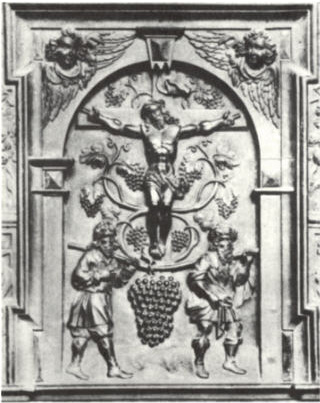
In Christian ideology, all the former pagan sun-gods who suffer
and die a Christ-like death, only to be resurrected, are amalgamated
into the figure of Jesus Christ, who is then presented as the sole
and legitimate example of the cosmic savior. However, the evidence
of pagan origins continues to adhere to the Christian savior. A
Swiss Cathedral door cast in the 18th century depicts the crucified
savior embellished with grape clusters, the motif of one of his
pagan counterparts, Dionysos.
Angels
and Aliens by Keith Thompson. An original and far-ranging
treatment of the UFO/ET question, demonstrating how beliefs
about extraterrestrial intervention contain all the elements
of a full-blown
religious system. A deep study of the symbolic and psychological
dimensions of the UFO phenomenon, this book explores the boundaries
between what is real and what is imagined, and it shows how
often beliefs determine where those boundaries are located.
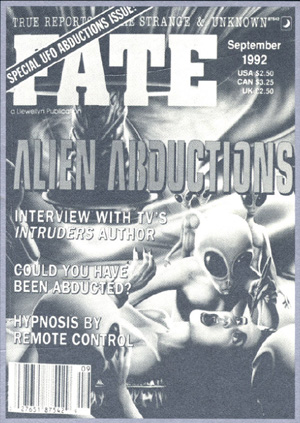
The theme of the intervention of an alien or extraterrestrial
species into human affairs occurs in Sumerian texts that
date from 3400
BCE. The belief that aliens "seeded" humanity on
earth and brought technology from their world has been revived
since
1947 when the Roswell crash was alleged to occur. This belief
is almost always coupled with the assumption that humanity
is incapable
of advancing solely by its own potential. (Cover of Fate Magazine,
September 1992)
Supernature by
Lyall Watson. A sober, eye-opening look at the realm of paranormal
phenomena, raising many questions about humanity’s relation
to the powers of the physical world (Sacred Nature) and the use
of its hidden potential for good or evil (Moral Design). Extensively
researched, this book focuses on the question of how human potential
may be repressed by religious beliefs and denied by scientific
dogmas (beliefs in disguise). It exposes many scripts that carry
assumptions about what is and is not possible to us through the
exploration of our own inborn faculties.
Gaia: The
Practical Science of Planetary Medicine by James Lovelock,
co-author of the Gaia Hypothesis, proposing that the earth is
a dynamic entity able to control its own life processes. Here
is
a new story about the life of the earth, which might change
our view of the human presence in the natural world. Through
his vivid description of the geophysiology of the planet, Lovelock
reformulates the master theme of Sacred Nature in the context
of
Technology. The debate over Gaia introduces a new scientific
paradigm that challenges many religious and scientific beliefs.
Gaia-Sophia Navigator
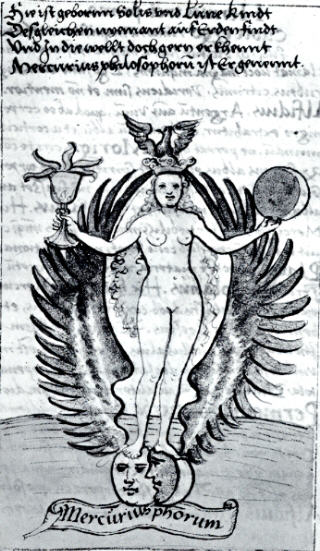
The Gaia Hypothesis reintroduces in rigorous scientific language
the belief common to indigenous peoples and some esoteric traditions,
such as alchemy: namely, that the earth is a living intelligence.
Gaia is Sophia (Wisdom), who imparts to humanity the moral and
practical knowledge necessary for its survival. In this role, the
earth-wisdom is invariably represented as a woman. (18th Century
alchemical manual, Sapientia veterum philosophorum)
Comments on Basic Reading
|
|


